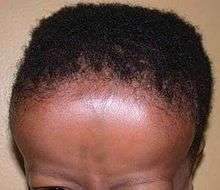Skull bossing
Skull bossing is the protuberance of various bones of the skull which most often occurs in the frontal bones beneath the forehead. Skull bossing may be due to a variety of medical conditions[1] such as when a decrease in bone marrow volume leads to depressed intramedullary hematopoiesis.[2]
Frontal bossing
Frontal bossing is the development of an unusually pronounced forehead which may also be associated with a heavier than normal brow ridge. It is caused by enlargement of the frontal bone, often in conjunction with abnormal enlargement of other facial bones, the skull, the mandible and bones in the hands and feet. Frontal bossing is usually seen in a few rare medical syndromes such as acromegaly - a chronic medical disorder in which the anterior pituitary gland produces excess growth hormone (GH).[3]
Associated medical disorders

- Rickets[4]
- Achondroplasia
- Acromegaly
- Basal cell nevus syndrome
- Congenital syphilis
- Cleidocranial dysostosis
- Crouzon syndrome
- Ectodermal dysplasia
- Extramedullary hematopoiesis
- Fragile X syndrome
- Hurler syndrome
- Pfeiffer syndrome
- Rubinstein-Taybi syndrome
- Russell-Silver syndrome (Russell-Silver dwarf)
- Trimethadione (antiseizure drug) use during pregnancy
- Beta-thalassemia (due to expansion of bone marrow secondary to increased hematopoiesis)[5]
References
- ↑ Dennis, Mark; Bowen, William Talbot; Cho, Lucy (2012). "Frontal bossing". Mechanisms of Clinical Signs. Elsevier. p. 520.
- ↑ M. Sperling: Pediatric Endocrinology. p.748 Saunders; 3 edition (2008) ISBN 1416040900
- ↑ PubMed Health: Frontal bossing
- ↑ Nelson Textbook of Pediatrics, 19e. Chapter 48
- ↑ Bope, Edward T., and Rick D. Kellerman. "Chapter 13 - Hematology." Conn's Current Therapy: Latest Approved Methods of Treatment for the Practicing Physician. Philadelphia: Saunders Elsevier, 2012.